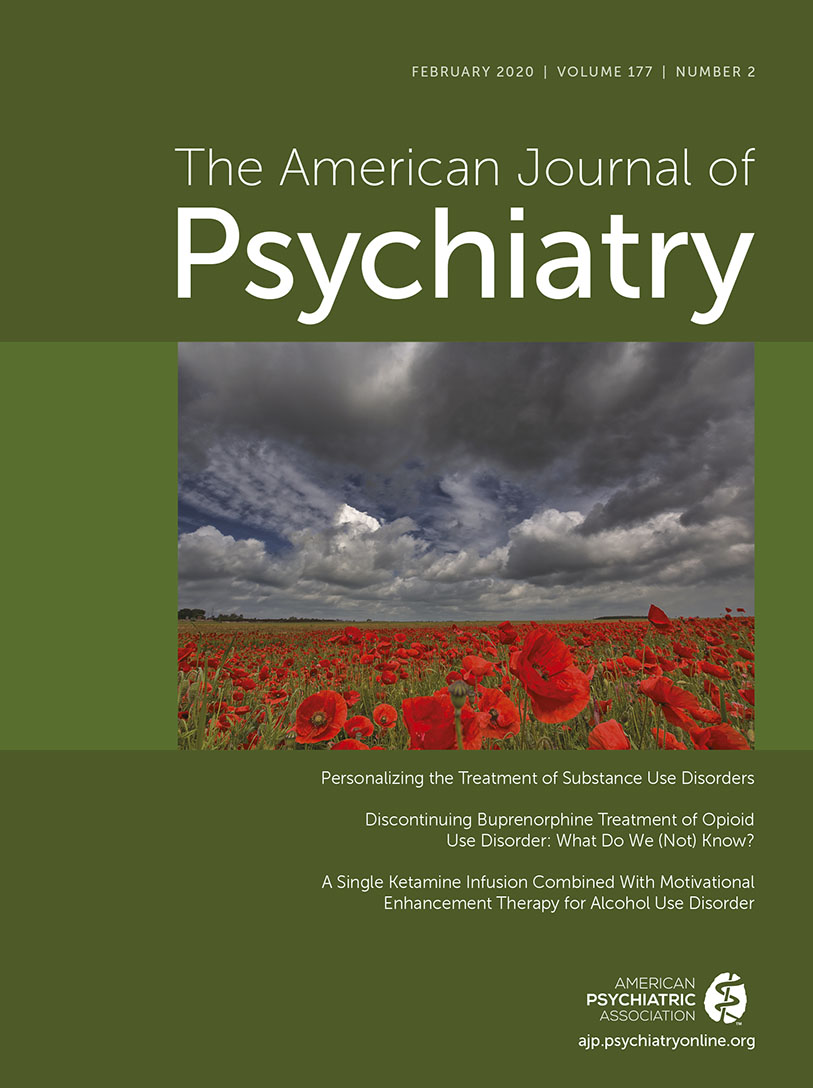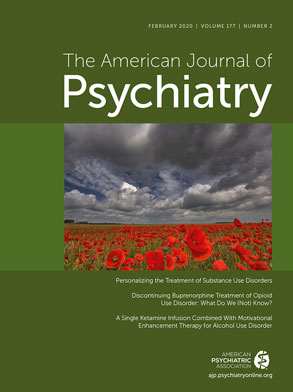This issue of the
Journal presents innovative original research reflecting a mixture of topics. The issue begins with an emphasis on substance use disorders. We are fortunate to have, as a centerpiece, an overview on progress in conceptualizing new treatment strategies and treatment targets for substance use disorders authored by Dr. Nora Volkow, director of the National Institute on Drug Abuse (
1). Dr. Volkow’s overview provides a foundation for the two articles that follow that are directly related to the treatment of substance use disorders. The first article considers the consequences of buprenorphine discontinuation in the treatment of opioid use disorder, and the second presents data from a study that combined a ketamine infusion with motivational enhancement therapy for the treatment of alcohol use disorder. These articles are then followed by a study assessing the efficacy of health coaches and smartphone technology to deliver cognitive-behavioral self-help therapy as a treatment for binge eating. Like substance use disorders, binge-eating disorder and bulimia nervosa are illnesses that also likely involve neural pathways that underlie reward, reinforcement learning, and addictive processes.
Another area of considerable interest involves the use of brain-based measures to help in treatment selection and in predicting treatment responsivity. This approach is taken in an article presented in this issue using resting-state functional connectivity measures in a large sample of depressed patients prior to treatment. With the recognition that earlier diagnoses and interventions have the potential to improve outcomes, researchers are increasingly focusing their efforts on understanding the early-life antecedents of psychiatric illnesses. In relation to this, we include two articles in this issue exploring factors, such as longitudinal symptom trajectories and polygenic risk scores, that are associated with the risk to develop psychotic disorders.
The first article in this issue deals with concerns relevant to the long-term treatment of individuals with opioid use disorder. Buprenorphine, a partial mu opioid receptor agonist, is commonly used as a replacement strategy for treating opioid use disorder, and in their article, Williams and colleagues (
2) provide new data regarding the negative consequences of buprenorphine discontinuation. Although it is clinically accepted that longer treatment is better, this study systematically examined data from patients with opioid use disorder who were compliant with treatment from at least 6 months up to 18 months. The authors specifically studied adverse health outcomes during the first 6 months after discontinuation of buprenorphine. Not surprisingly, the data demonstrate that discontinuation is associated with poor outcomes (e.g., emergency department visits, inpatient hospitalizations, and filling opioid prescriptions), supporting the imperative for long-term treatment. The worst outcomes occurred in the group who received treatment for the least amount of time, 6–9 months. However, while not of the same magnitude, adverse events were also common following discontinuation even in patients who were treated for 15 to 18 months. It is important to emphasize that across all patients treated from 6 to 18 months, 5% of individuals received treatment for an overdose during the discontinuation period. In their editorial (
3), Drs. Hilary Connery and Roger Weiss, substance use disorder experts from McLean Hospital at Harvard Medical School, comment on these findings and provide an overview of practical issues in the treatment of opioid use disorder. They strongly emphasize the importance of very long-term continuous maintenance therapy in patients with opioid use disorder.
In the next article, Dakwar et al. (
4) present findings regarding the use of ketamine in combination with motivational enhancement therapy to treat individuals with alcohol use disorder. This article builds on prior work from this group demonstrating that a single ketamine infusion combined with mindfulness-based behavioral modification improved treatment outcomes in patients with cocaine dependence (
5). Here, in patients with alcohol use disorder, using midazolam infusions as a comparator, the authors show that the intravenous administration of subanesthetic doses of ketamine, an
N-methyl-
d-aspartate glutamate receptor antagonist, appears to augment the effects of motivational enhancement therapy. While performed in a small group of patients who were followed only for 3 weeks postinfusion, the findings demonstrate that compared with midazolam plus psychotherapy, ketamine plus psychotherapy resulted in an increased likelihood of abstinence and fewer heavy drinking days. This finding adds to the intriguing observations that regardless of the substance(s) being overused, acute ketamine administration may synergize with psychosocial interventions to promote recovery in addicted patients. In an accompanying editorial, Dr. Sanjay Mathew from the Menninger Department of Psychiatry and Behavioral Sciences at Baylor University along with Dr. Rebecca Price from the Department of Psychiatry at the University of Pittsburgh consider these findings in more detail and also caution the reader about overinterpreting these preliminary findings (
6). They also underscore the promise of emerging strategies that are exploring, across different diagnoses, the use of psychopharmacological agents to enhance the effects of psychosocial interventions.
In an article with potential “real world” significance for the treatment of binge-eating disorder and bulimia nervosa, Hildebrandt and coauthors (
7) present data supporting an intervention that uses health coaches via telemedicine combined with smartphone cognitive-behavioral guided self-help therapy. In this randomized clinical trial in a population from Kaiser Permanente Northwest, the authors compared the efficacy of this intervention with treatment as usual, which in this case did not involve specific treatment for eating disorders and actually featured very little treatment at all. Perhaps not surprisingly in comparison with the treatment as usual group, the results support the use of this relatively inexpensive intervention that uses coaches with minimal training, telephone therapy, and smartphones. At 1-year follow-up, individuals who received the new treatment were reported to have remission rates of 57%, compared with 30% for the treatment as usual group. When considering the relative efficacy of this treatment, it is important to appreciate that the comparator, the treatment as usual group, was essentially not an intervention. In addition, because of the design of this study, it is not possible to know the extent to which the different elements of the intervention (i.e., coaches with minimal training, telephone therapy, and smartphones) contributed to its efficacy. In his editorial (
8), Carlos Grilo, a leader in eating disorders from Yale University, emphasizes the importance of scalable treatments and the use of technology in their delivery but also delineates methodological issues that affect the interpretation of the findings.
We next present an article that uses functional brain connectivity measures prior to placebo or sertraline treatment to predict the likelihood of antidepressant response in a large sample of depressed patients from the Establishing Moderators and Biosignatures of Antidepressant Response in Clinical Care study. In their article using resting-state functional MRI, Chin Fatt et al. (
9) characterize the patterns of functional connectivity between and within numerous well-known cortical networks (i.e., default mode, salience, executive control, cingulo-opercular, dorsal attention, limbic, somatomotor, and visual) as well as with key subcortical regions. Among other findings, the results demonstrated that sertraline responsivity was selectively associated with greater connectivity within the default mode network as well as with greater connectivity between the default mode and executive control networks. Hippocampal connectivity was related to both sertraline and placebo response but involved different connectivity patterns. For example, higher connectivity between the hippocampus and amygdala predicted sertraline responsivity, whereas higher network connectivity between the hippocampus and the visual network, dorsal attention network, and executive control network, along with decreased connectivity to the salience network, predicted placebo response. Other connectivity patterns were identified that predicted responsivity to both sertraline and placebo. These intriguing findings provide an understanding of not only the heterogeneity in the neural circuit functional patterns that are found in individuals with depression but also of the possibility of using these types of measures clinically, as indicators for treatment selection.
Finally, two articles in this issue address factors related to the risk to develop psychosis. In the first article, from the North American Prodrome Longitudinal Study, Perkins et al. (
10) test the utility of using a polygenic risk score (PRS) to predict the development of psychosis in a clinically high-risk, help-seeking population. A PRS, which reflects a measure of genome-wide risk, is now being widely used to understand the role of genetic risk in psychiatric disorders, including schizophrenia, that have complex genetic underpinnings (
11). In the European subsample from this study cohort, the authors demonstrate higher PRSs in individuals who subsequently develop psychoses when compared with at-risk nonconverters and unaffected individuals. In the non-European subsample, a significant difference in PRSs was found only when comparing individuals who developed psychosis with unaffected individuals. Some of the authors involved in this study previously developed a psychosis risk prediction calculator (
12) that, based on historical data, social functioning, and cognitive performance, demonstrated good predictive value for conversion to psychosis. In the present study, the authors tested the extent to which adding a PRS to the psychosis risk calculator improved its predictive value. Their results suggest that the addition of the PRS modestly increases the predictive value of their model, but the authors point out that this should improve as we develop a more in-depth and reliable understanding of the genetic and epigenetic factors associated with psychosis.
In a second article, written by many of the same authors and using at-risk subjects from the sample in the study discussed above, Allswede et al. (
13) use trajectory modeling to understand how longitudinal ratings of symptoms and functional measures are related to outcomes. By following this high-risk group across 2 years, starting on average at 18.5 years of age, the authors identified three trajectory groups that likely will be highly clinically relevant. One of the groups demonstrated significant improvement over time, with 50% of individuals showing reductions in positive symptom severity and significant functional improvement. The second group was moderately impaired and remained symptomatically stable over the 2 years of study, with 25% having positive outcomes. The third group was more severely impaired and did not show positive outcomes.
These findings are important because they provide a longitudinal method by which we can be clearer about the varying degrees of risk associated with the development of psychotic disorders. The identification of these different trajectories lays the foundation for examining other factors, including neural circuit alterations and genetic variation, that may underlie symptomatic and functional improvement or worsening in at-risk individuals. It will be very interesting to understand how PRSs, as used in the article by Perkins et al., relate to the different risk trajectories characterized by Allswede et al. Additionally, the identification of these trajectory groups could eventually have treatment implications, as levels of care intensity could be prospectively rationed to those individuals who are at the greatest risk to stay severely impaired and to develop full-blown psychotic disorders.

